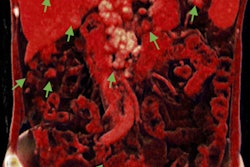A new imaging technique based on photoacoustic imaging could help clinicians detect ovarian cancer earlier, according to researchers from Washington University in St. Louis.
A team led by Quing Zhu, PhD, and colleagues conducted a pilot study using coregistered photoacoustic tomography with ultrasound to evaluate ovarian tumors in 16 patients. Their findings were published online September 11 in Radiology.
Photoacoustic imaging uses sound and light to visualize a tumor's vasculature, making ultrasound imaging of ovarian masses more effective, the group wrote. Zhu's team developed a sheath with optical fibers connected to a laser that wraps around a standard transvaginal ultrasound probe; when the probe is inside the patient, the laser shines through the vaginal muscle and reveals information about the tumor's angiogenesis.
The researchers used two biomarkers to characterize the ovaries: relative total hemoglobin concentration (rHbT), which is directly related to tumor angiogenesis, and mean oxygen saturation. They found that the rHbT value was 1.9 times higher for ovaries with invasive epithelial cancer detected on photoacoustic imaging -- which make up 90% of ovarian cancers -- than for normal ovaries. The mean oxygen saturation of invasive epithelial cancers found on photoacoustic imaging was 9.1% lower than in normal and benign ovaries, the team wrote.
"This technology may provide a means to improve early ovarian cancer detection, help avoid surgery in most patients with a normal or benign ovary, substantially reduce medical costs, and improve women's quality of life," Zhu said in a statement released by the university on November 14.



















